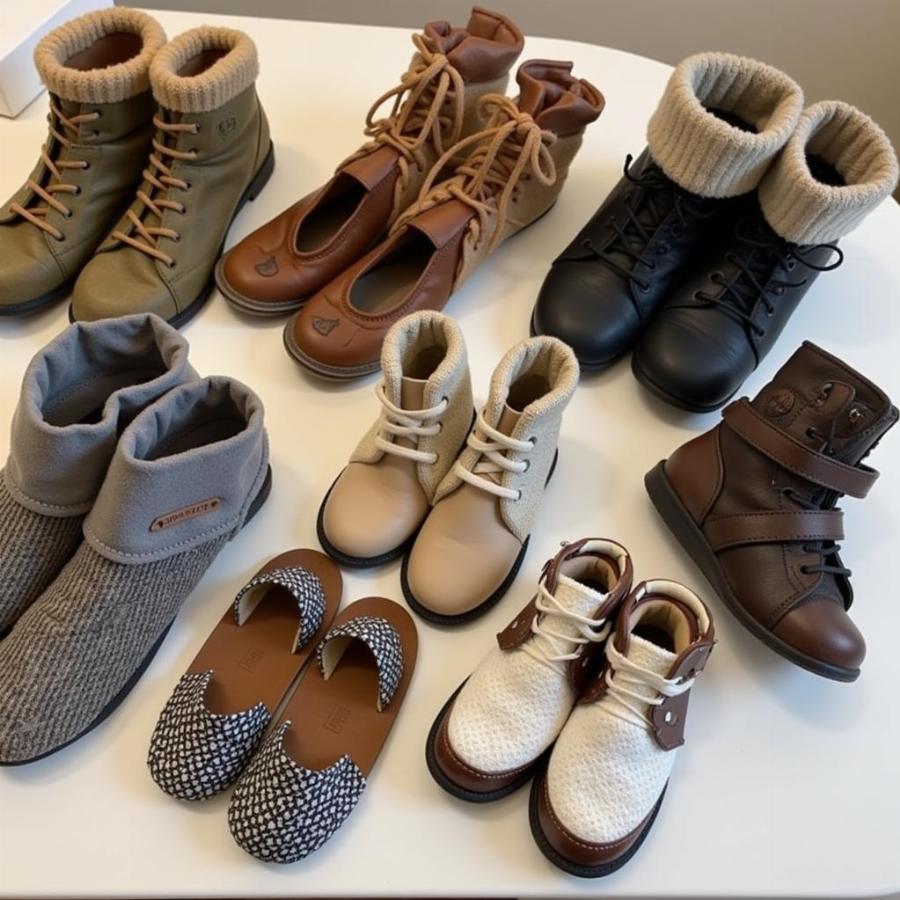Finding the right footwear for your furry friend might seem like a fashion statement, but did you know that small shoes for dogs can actually be beneficial for their health and well-being? Whether you’re protecting their paws from harsh weather conditions or providing extra traction on slippery surfaces, dog shoes serve a practical purpose. But with so many options available, choosing the right pair can feel overwhelming. This comprehensive guide will explore everything you need to know about small shoes for dogs, ensuring you find the perfect fit for your canine companion.
Why Your Dog Might Need Small Shoes
While some may consider dog shoes a fashion accessory, they can be incredibly beneficial in various situations.
- Protection from the elements: Extreme temperatures, whether hot pavement in the summer or ice and snow in the winter, can wreak havoc on sensitive paw pads. Dog shoes act as a barrier, shielding their paws from burns, frostbite, and irritating chemicals like salt or de-icer.
- Traction and support: For senior dogs or those with mobility issues, dog shoes can provide added traction on slippery floors or uneven terrain. This extra grip can prevent slips and falls, keeping your furry friend safe and confident.
- Medical reasons: Dogs recovering from paw injuries or suffering from allergies may benefit from wearing shoes. Shoes can keep wounds clean, prevent licking and irritation, and minimize contact with allergens.
Choosing the Right Small Shoes for Your Dog
Finding the right shoes for your dog requires careful consideration to ensure a comfortable and secure fit.
Measuring Your Dog’s Paws
Accurate paw measurements are crucial for finding shoes that fit properly. To measure your dog’s paws:
- Place a piece of paper on a flat surface.
- Gently press your dog’s paw onto the paper, ensuring their weight is evenly distributed.
- Use a pen to trace around the paw, including the nails.
- Measure the widest part of the paw tracing for width and the longest part from the back of the paw pad to the tip of the longest nail for length.
- Repeat for all four paws, as there might be slight size variations.
Expert Tip: Measure your dog’s paws after a walk when they’re relaxed and their paws are naturally spread.
Types of Dog Shoes
Dog shoes come in various styles, each designed for different purposes:
- Booties: These resemble small boots and offer comprehensive paw protection from extreme weather, rough terrain, and allergens.
- Socks: Ideal for indoor use, socks provide traction on slippery floors and can help senior dogs maintain their balance.
- Sandals: Lightweight and breathable, sandals protect paw pads from hot surfaces while allowing for natural paw movement.
Factors to Consider When Choosing Shoes
- Material: Choose breathable and durable materials like mesh, leather, or synthetic fabrics.
- Sole: Opt for waterproof and non-slip soles with good traction.
- Fit: Shoes should be snug but not too tight, allowing for natural paw movement.
- Closure: Velcro straps or buckles provide a secure fit and are easy to adjust.
- Visibility: Reflective strips enhance visibility during nighttime walks.
 Different types of dog shoes
Different types of dog shoes
Introducing Your Dog to Shoes
Getting your dog accustomed to wearing shoes takes patience and positive reinforcement:
- Start slowly: Introduce the shoes gradually, allowing your dog to sniff and investigate them.
- Reward positive associations: Offer treats and praise when your dog interacts calmly with the shoes.
- Short sessions: Begin with short wearing sessions, gradually increasing the duration as your dog becomes more comfortable.
- Positive reinforcement: Make wearing shoes a positive experience with treats, praise, and fun activities.
Keeping Those Paws Stylish and Safe
Finding the right small shoes for your dog doesn’t have to be a chore. By considering your dog’s needs, measuring their paws accurately, and gradually introducing the shoes, you can ensure a comfortable and safe fit. Remember, happy paws make for happy walks!
FAQs about Small Shoes for Dogs
Do all dogs need shoes?
Not all dogs require shoes, but they can be beneficial for protection, traction, and medical reasons.
How do I know if my dog’s shoes fit correctly?
A proper fit allows for natural paw movement without being too tight. You should be able to fit two fingers between the shoe and your dog’s paw.
Can my dog wear shoes all day?
It’s best to limit shoe-wearing to outdoor walks or when necessary. Prolonged use can cause discomfort and potential paw problems.
How do I clean my dog’s shoes?
Most dog shoes can be hand-washed with mild soap and water. Allow them to air dry completely before the next use.
Where can I find stylish and functional small shoes for my dog?
Numerous pet stores and online retailers offer a wide selection of dog shoes. matching dog hoodies may also be a fun addition to your dog’s wardrobe.
Looking for more paw-some tips and tricks?
Check out these related articles on Beaut Dogs:
Beaut Dogs is your one-stop resource for all things dog-related, providing expert advice and helpful information to enhance the lives of dogs and their owners. For personalized support and answers to your specific questions, don’t hesitate to reach out to our team at [email protected]. We’re here to help you navigate the wonderful world of dog ownership with confidence and care!